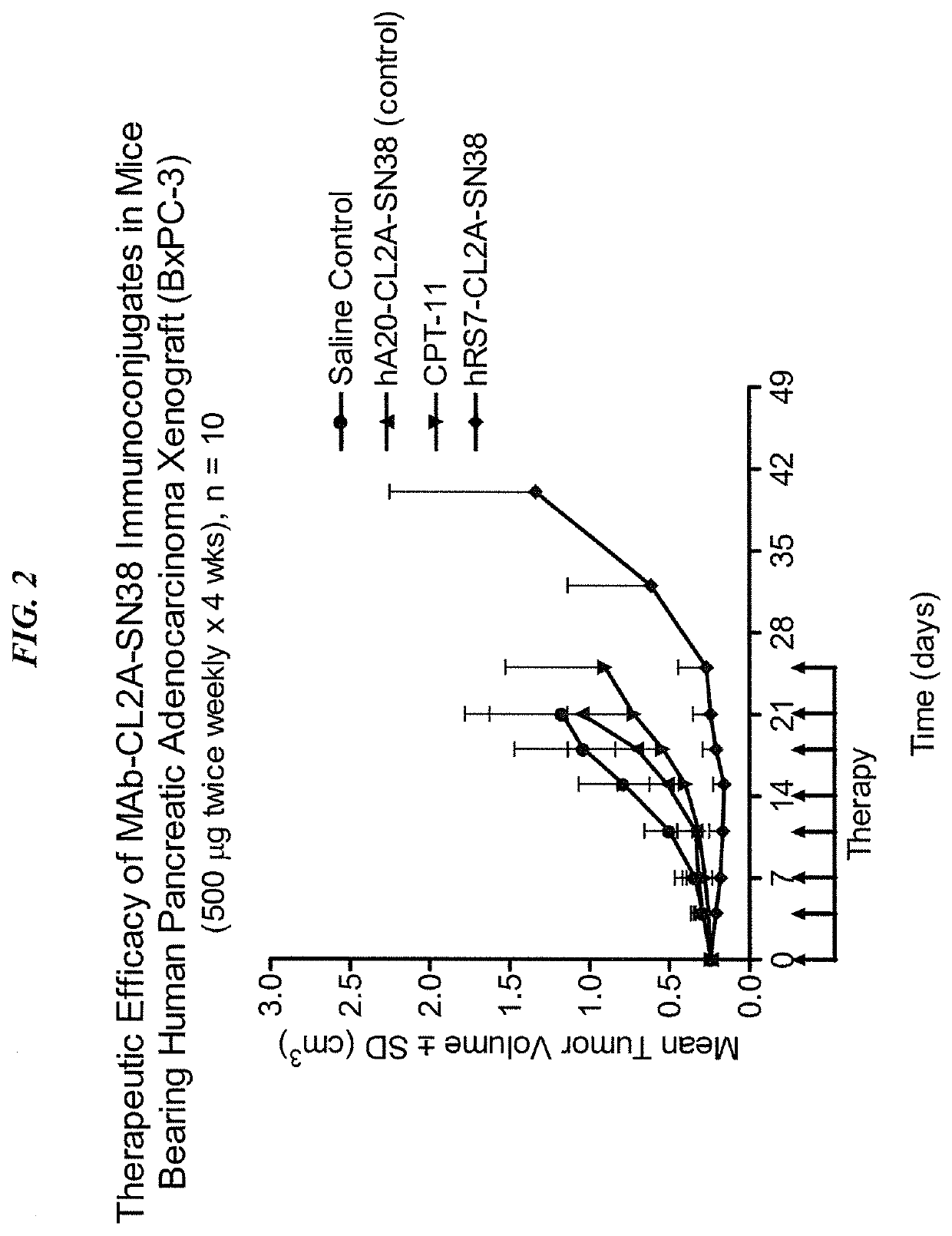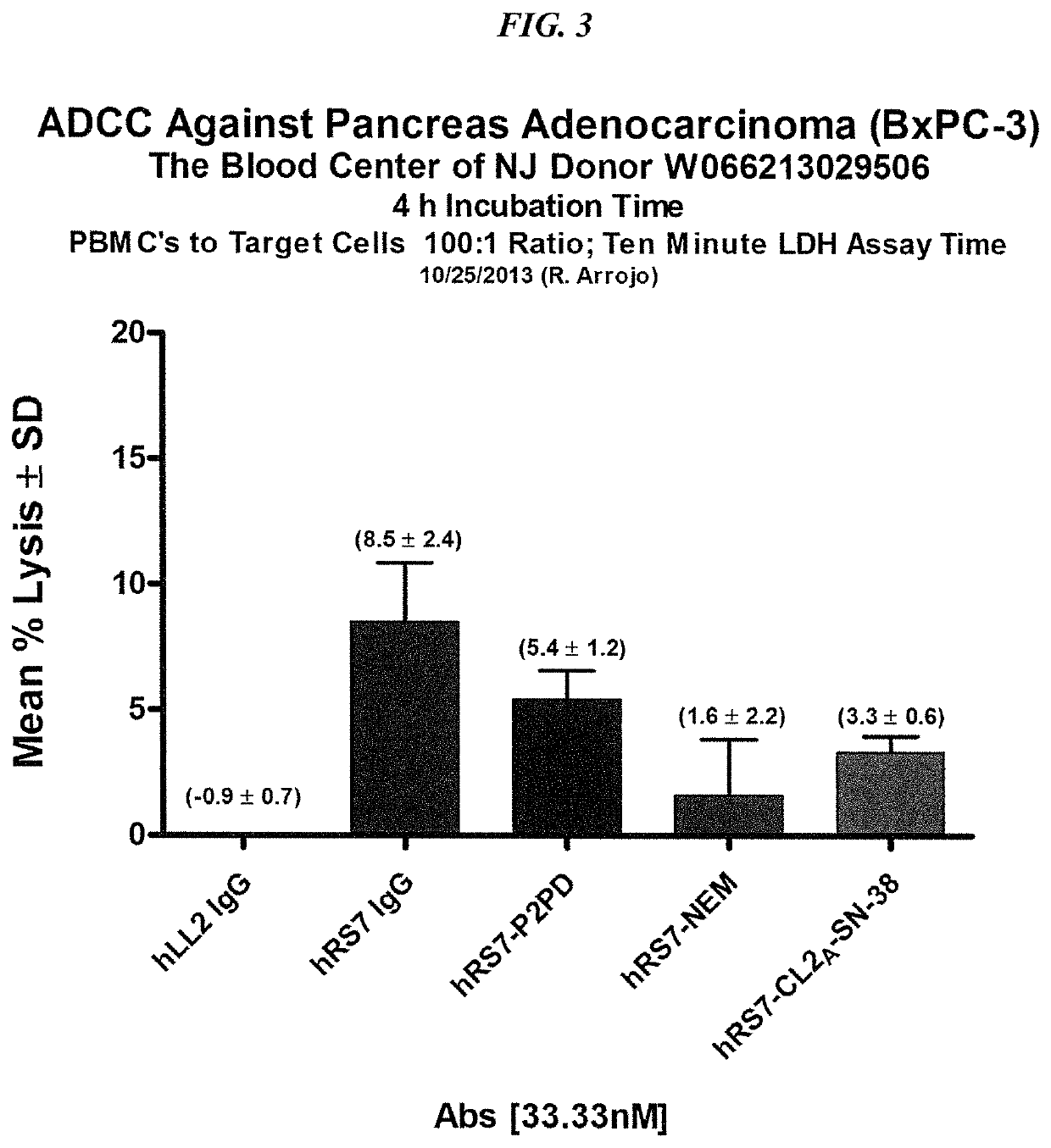Combination of ABCG2 inhibitors with sacituzumab govitecan (IMMU-132) overcomes resistance to SN-38 in Trop-2 expressing cancers
a technology of sacituzumab and govitecan, which is applied in the field of conjugation therapy with antitrop2 antibody drugs, can solve the problems of poor overall prognosis, inability to predict immunological function in mice, etc., and achieve the effect of reducing the course of therapy required, reducing certain severe side effects, and reducing dosage and/or frequency of administration
- Summary
- Abstract
- Description
- Claims
- Application Information
AI Technical Summary
Benefits of technology
Problems solved by technology
Method used
Image
Examples
example 1
n and Use of Anti-Trop-2-SN-38 Antibody-Drug Conjugate
[0229]The humanized RS7 (hRS7) anti-Trop-2 antibody was produced as described in U.S. Pat. No. 7,238,785, the Figures and Examples section of which are incorporated herein by reference. SN-38 attached to a CL2A linker was produced and conjugated to hRS7 (anti-Trop-2), hPAM4 (anti-MUC5ac), hA20 (anti-CD20) or hMN-14 (anti-CEACAM5) antibodies according to U.S. Pat. No. 7,999,083 (Example 10 and 12 of which are incorporated herein by reference). The conjugation protocol resulted in a ratio of about 6 SN-38 molecules attached per antibody molecule.
[0230]Immune-compromised athymic nude mice (female), bearing subcutaneous human pancreatic or colon tumor xenografts were treated with either specific CL2A-SN-38 conjugate or control conjugate or were left untreated. The therapeutic efficacies of the specific conjugates were observed. FIG. 1 shows a Capan 1 pancreatic tumor model, wherein specific CL2A-SN-38 conjugates of hRS7 (anti-Trop-2)...
example 2
vity of Anti-Trop-2 ADCs
[0231]The ADCC activity of various hRS7-ADC conjugates was determined in comparison to hRS7 IgG (FIG. 3). PBMCs were purified from blood purchased from the Blood Center of New Jersey. A Trop-2-positive human pancreatic adenocarcinoma cell line (BxPC-3) was used as the target cell line with an effector to target ratio of 100:1. ADCC mediated by hRS7 IgG was compared to hRS7-Pro-2-PDox, hRS7-CL2A-SN-38, and the reduced and capped hRS7-NEM. All were used at 33.3 nM.
[0232]Results are shown in FIG. 3. Overall activity was low, but significant. There was 8.5% specific lysis for the hRS7 IgG which was not significantly different from hRS7-Pro-2-PDox. Both were significantly better than hLL2 control and hRS7-NEM and hRS7-SN-38 (P<0.02, two-tailed t-test). There was no difference between hRS7-NEM and hRS7-SN-38.
example 3
of Anti-Trop-2-SN-38 ADC Against Diverse Epithelial Cancers In Vivo
[0233]Abstract
[0234]The purpose of this study was to evaluate the efficacy of an SN-38-anti-Trop-2 (hRS7) ADC against several human solid tumor types, and to assess its tolerability in mice and monkeys, the latter with tissue cross-reactivity to hRS7 similar to humans. Two SN-38 derivatives, CL2-SN-38 and CL2A-SN-38, were conjugated to the anti-Trop-2-humanized antibody, hRS7. The ADCs were characterized in vitro for stability, binding, and cytotoxicity. Efficacy was tested in five different human solid tumor-xenograft models that expressed Trop-2 antigen. Toxicity was assessed in mice and in Cynomolgus monkeys.
[0235]The hRS7 conjugates of the two SN-38 derivatives were equivalent in drug substitution (−6), cell binding (Kd˜1.2 nmol / L), cytotoxicity (IC50˜2.2 nmol / L), and serum stability in vitro (t / 1 / 2˜20 hours). Exposure of cells to the ADC demonstrated signaling pathways leading to PARP cleavage, but differences v...
PUM
| Property | Measurement | Unit |
|---|---|---|
| size | aaaaa | aaaaa |
| structure | aaaaa | aaaaa |
Abstract
Description
Claims
Application Information
 Login to View More
Login to View More - R&D
- Intellectual Property
- Life Sciences
- Materials
- Tech Scout
- Unparalleled Data Quality
- Higher Quality Content
- 60% Fewer Hallucinations
Browse by: Latest US Patents, China's latest patents, Technical Efficacy Thesaurus, Application Domain, Technology Topic, Popular Technical Reports.
© 2025 PatSnap. All rights reserved.Legal|Privacy policy|Modern Slavery Act Transparency Statement|Sitemap|About US| Contact US: help@patsnap.com



